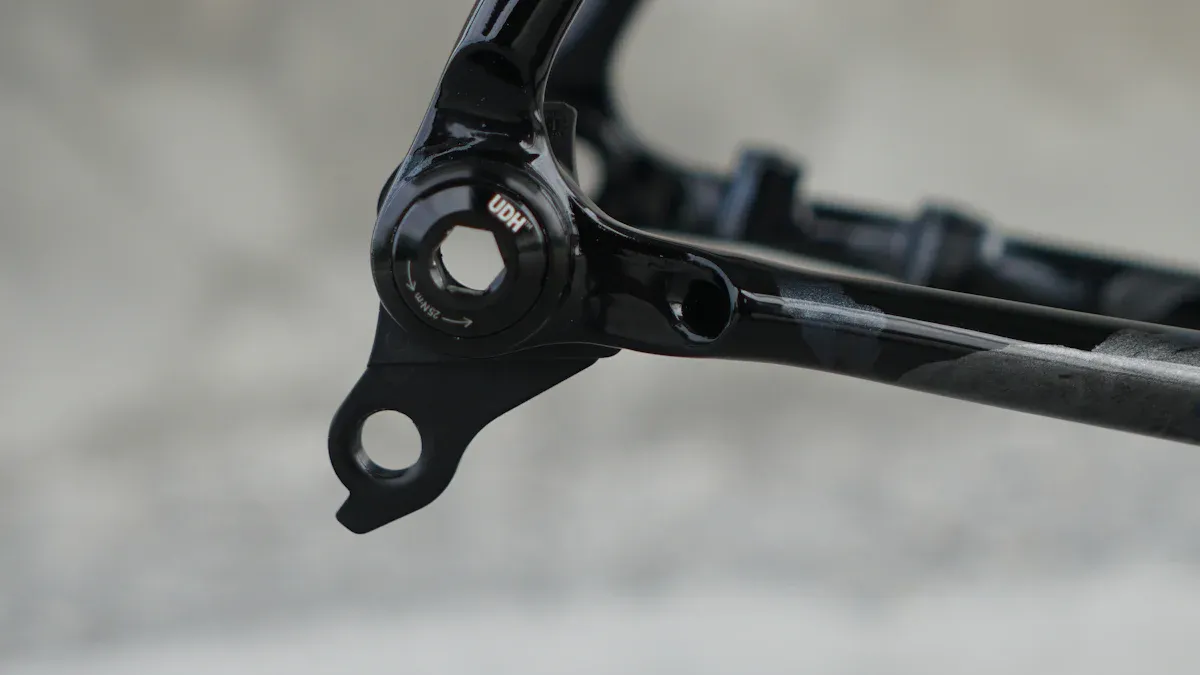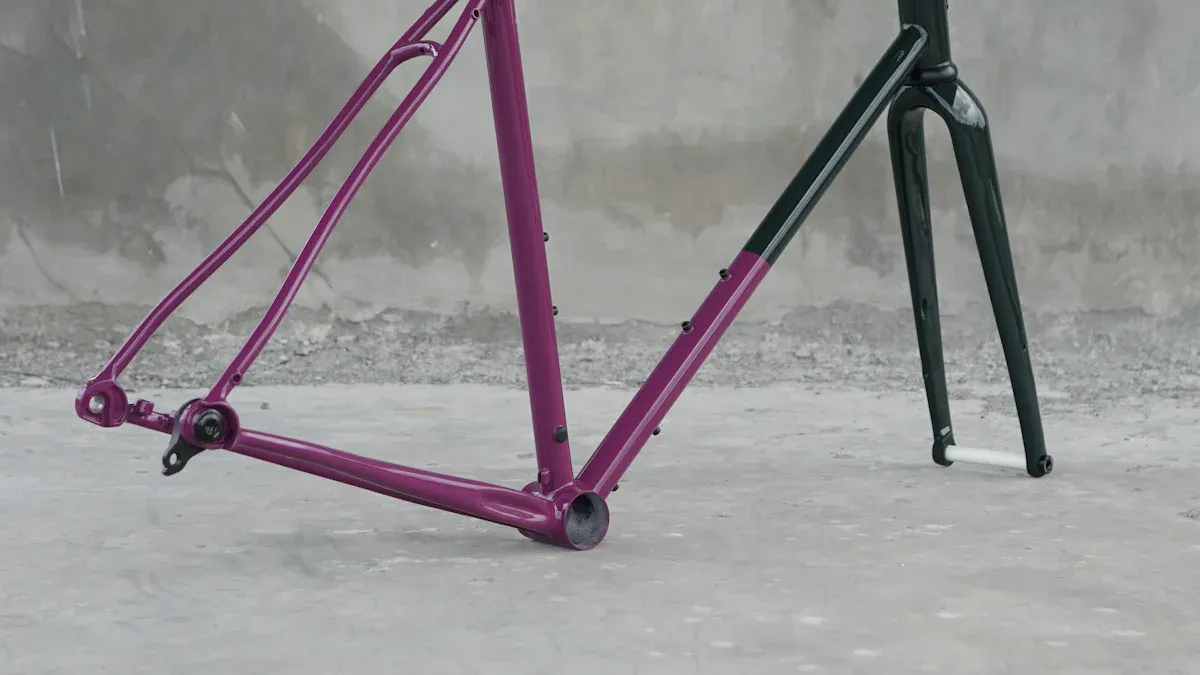
Choosing the best material for your mountain bike frame is very important, and understanding the mountain bike frame diagram can help you visualize the different components. The frame material affects how your bike performs, its weight, and how long it lasts. For instance, a stiffer frame can help you ride better but might make you uncomfortable on bumpy trails. Knowing about different bike frame materials like aluminum, steel, carbon fiber, and titanium helps you make smart choices.
Key Takeaways
Picking the right bike frame material changes how well it works, how heavy it is, and how long it lasts. Think about how you ride when you decide.
Aluminum frames are light and cheap but can break easily. They are good for riders on a budget.
Carbon fiber frames are strong and comfy but cost more. They are perfect for serious mountain bikers who want to go fast.
Aluminium Bike Frames

Characteristics
Aluminum bike frames are liked by mountain bikers for many reasons. First, aluminum is light. This makes it easier to handle your bike. It helps a lot when climbing hills or going over tough trails. This material has a good mix of strength and weight. This mix is important for how well your bike works.
Aluminum frames usually use special alloys to make them better. The most common alloys are:
Alloy | Yield Strength (MPa) | Key Properties | |
|---|---|---|---|
6061 | >260 | >240 | Good against rust, easy to machine, great for welding |
7005 | Higher than 6061 | Not specified | Stronger, better at handling wear |
These alloys help make aluminum bike frames strong and long-lasting.
Pros and Cons
When thinking about aluminum bike frames, you should look at the good and bad sides carefully.
Advantages:
Weight: Aluminum is light. This makes bikes easier to handle, speed up, and climb hills.
Corrosion Resistance: Aluminum does not rust. This helps it last longer in different weather and wet conditions. This is great for bikes used in many places.
Cost: Aluminum frames usually cost less than titanium or carbon frames. This makes them a good choice for many riders. The way they are made is simpler. It takes less time and skill, which helps keep prices low.
Aluminum is easier to make than carbon fiber and titanium.
The making process takes less time and skill, lowering costs.
This makes aluminum frames a good choice for budget-conscious cyclists.
Disadvantages:
Durability Issues: Aluminum frames can break at the welds. This can happen when doing big jumps. After welding, they might get weaker. This can cause cracks that grow slowly, giving a warning before breaking.
Fatigue and Stress Cracking: Aluminum can get tired and crack under stress. This can lead to serious problems if not checked.
Steel Frames
Characteristics
Steel bike frames are strong and last a long time. They give a solid ride, which makes them popular with mountain bikers. Steel can handle rough trails well without breaking. There are different types of steel used in bike frames. Each type has its own special features. For example, Reynolds 853 is very strong and resists damage. Columbus XCR is great for welding and does not rust easily. Here’s a quick look at some common steel types:
Steel Type | UTS (MPa) | Key Properties |
|---|---|---|
Reynolds 853 | 1250-1400 | Very strong, resists damage, thin walls for less weight, structures that resist fatigue. |
Columbus XCR | 1750-2050 | High resistance to fatigue, great for welding, high stiffness/weight ratio, does not rust easily. |
Reynolds 631 | 800-900 | Tough, lasts long, comfortable for long rides, good for MTB and BMX. |
Pros and Cons
When thinking about steel bike frames, you should look at the good and bad sides carefully.
Advantages:
Durability: Steel frames are tough. They can handle dings, bends, and scratches. This means they last a long time.
Repairability: If a steel frame gets damaged, it is easy to fix. This makes it a good choice for beginners.
Ride Quality: Steel absorbs shocks well. This gives a comfy ride on bumpy trails.
Disadvantages:
Weight: Steel is heavier than aluminum and carbon fiber. This can be a problem for racers.
Rust: Steel can rust if not taken care of. Regular maintenance can help with this.
The main issues with steel frames are rust and weight. You can manage rust with good care. However, steel, except for stainless types, can rust over time.
Carbon Fiber Bike Frames
Characteristics
Carbon fiber bike frames are special because they are very strong and light. This material is about 3.8 times stronger than aluminum. That’s why serious mountain bikers like it. Carbon fiber frames are much lighter than steel or aluminum. This makes them easier to handle and helps you go faster.
Here’s a quick look at the main features of carbon fiber:
High Strength: Carbon fiber is very strong. It can take a lot of force without breaking.
Vibration Damping: This material absorbs bumps well. You will have a smooth ride, especially on rough paths.
Customizable Design: Makers can shape carbon fiber for better comfort. This helps with shock absorption on long rides.
Factor | Description |
|---|---|
Resin Matrix | High-quality resins protect carbon fiber and help it last longer. |
Manufacturing Process | Good curing methods and careful quality checks make sure it works well over time. |
Environmental Factors | Extreme heat and moisture can harm the resin. |
Physical Stress | Hard hits or constant pressure can weaken the structure. |
Pros and Cons
When thinking about carbon fiber bike frames, you should look at the good and bad sides carefully.
Advantages:
Lightweight: Carbon fiber frames are much lighter than aluminum and steel. This makes them easier to handle and helps you speed up.
Comfort: The material absorbs bumps well, giving you a smooth ride. This is great for long rides.
Durability: With good care, carbon fiber parts can last over 50 years. They do not break down easily, so they stay strong over time.
Disadvantages:
Cost: Carbon fiber frames usually cost more than aluminum and steel. This can be a problem for people on a budget.
Impact Vulnerability: Even though carbon fiber is strong, it can crack if hit hard. Fixing it can be expensive and create waste.
Less Resilience: Compared to aluminum, carbon fiber frames might not handle dings and bends as well. This can affect how long they last.
In summary, carbon fiber bike frames have many bike frame advantages, like being light and comfortable. However, they also have bike frame disadvantages, such as higher prices and being more likely to get damaged.
Titanium Frames

Characteristics
Titanium bike frames are special because of their great features. They last a long time and resist damage. This means they can handle tough trails without breaking. Titanium has a natural layer called Titanium Dioxide. This layer stops rust, decay, and corrosion. Unlike steel, titanium does not rust in wet or salty places. This helps it perform well for a long time.
You will also like how titanium bends. It absorbs bumps, giving you a smoother ride. This makes it perfect for long rides on rough paths. Plus, titanium frames are very strong. They can last a lifetime, unlike aluminum or carbon fiber frames.
Pros and Cons
When thinking about titanium bike frames, you should look at the good and bad sides carefully.
Advantages:
Durability: Titanium frames do not rust or wear out easily. This makes them good for different weather.
Comfort: The natural bending of titanium absorbs shocks. This helps reduce tiredness on long rides.
Longevity: These frames can last for many years, keeping their performance over time.
Disadvantages:
Cost: Raw titanium is costly. Making these frames needs a lot of work and skill. For example, a steel Salsa Fargo frameset costs $999, but the titanium one costs $3,149.
Availability: You might only find titanium frames in special or custom shops.
Repairs: Fixing titanium frames can be hard.
Best Bike Frame Material Overview
When picking the best bike frame material, think about the good and bad sides of each choice. Here’s a quick summary:
Aluminum: It is light and cheap, but it can break easily.
Steel: It is strong and easy to fix, but it is heavier and can rust.
Carbon Fiber: It is very strong and comfortable, but it costs more and can crack if hit hard.
Titanium: It is very strong and comfy, but it is also expensive and hard to find.
Your riding style is important when choosing the right frame material. Here are some tips based on different riding types:
Cross-Country (XC) Frame: Go for a light carbon frame. This helps you ride better and pedal faster.
Enduro Frame: Pick a steel or aluminum frame for stability on downhill rides. These frames usually have full suspension for rough trails.
Trail Frame: A flexible aluminum frame is a good choice. It works well for climbing and going down hills, making it great for many trails.
Recent expert reviews show that carbon fiber and titanium are the top choices for serious riders. They like carbon fiber for being strong and light, and titanium for being tough and not rusting.
Finally, think about how much care your frame needs. Here’s a quick comparison:
Material | |
|---|---|
Carbon | Low to Moderate |
Titanium | Low |
Steel | Moderate |
Aluminum | Low to Moderate |
By knowing these things, you can choose the best bike frame material for you.
To sum up, every mountain bike frame material has its own good and bad points. Aluminum is light but not very strong. Steel is tough but heavier. Carbon fiber is strong and comfy, while titanium lasts a long time. Pick the right one for your riding style: use carbon for speed, steel for rough trails, and aluminum for all-around use.
FAQ
What is the best material for a mountain bike frame?
The best material depends on your riding style. Carbon fiber suits speed, while steel offers durability for rough trails.
How do I maintain my bike frame?
Regularly clean your frame and check for cracks or rust. Keep it dry and store it in a cool place.
Can I repair a damaged frame?
Yes, you can repair steel and aluminum frames easily. Carbon fiber repairs are possible but often costly and complex.
See Also
Comparing Enduro Bike Frame Materials For Durability And Strength
Essential Materials In Track Bike Frames And Their Importance
Evaluating Steel Mountain Bike Frames: Pros And Cons Explained
Identifying The Materials That Create The Lightest Bike Frames
Guidelines For Selecting The Perfect Carbon Mountain Bike Frame
